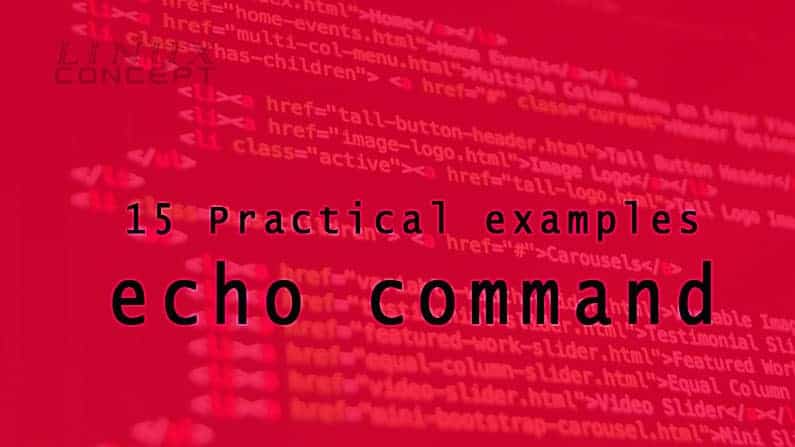echo [option(s)] [string(s)]
Examples:
Here, we list out some of the practical examples of the echo command. You will get the idea about “How to use the echo command in Linux or bash script?”.
Print a line of text on standard output screen
To print any text on the output screen, use echo command with the text string.
# echo "LinuxConcept Provides Linux tutorial for Linux Administrator"
Output on the Screen:
LinuxConcept Provides Linux tutorial for Linux Administrator
Display or print the value of variables
Use the echo command to display or print the value of variables. For example, declare a variable of z and assign its value 25.
# z=25 # echo "The value of variable Z = $z"
Output:
The value of variable z = 25
Use “\b” with backslash interpretor “-e”
We can use “\b” option with backslash interpretor “-e” to remove all spaces in between.
# echo -e "LinuxConcept \bProvides \bLinux \btutorial \bfor \bLinux \bAdministrator"
Output:
LinuxConceptProvidesLinuxtutorialforLinuxAdministrator
Use “\n” with backslash interpretor “-e”
We can use “\n” option with backslash interpretor “-e” to use new line where it is used.
# echo -e "LinuxConcept \nProvides \nLinux \ntutorial \nfor \nLinux \nAdministrator"
Output:
LinuxConcept Provides Linux tutorial for Linux Administrator
Use “\t” with backslash interpretor “-e”
We can use “\t” option with backslash interpretor “-e” to use horizontal tab spaces where it is used.
# echo -e "LinuxConcept \tProvides \tLinux \ttutorial \tfor \tLinux \tAdministrator"
Output:
LinuxConcept Provides Linux tutorial for Linux Administrator
Use “\t” and “\n” simultaneously
The echo command gives freedom to use the newline “\n” and horizontal tab space “\t” option simultaneously like below:
# echo -e "LinuxConcept \n\tProvides \n\tLinux \n\ttutorial \n\tfor \n\tLinux \n\tAdministrator"
Output:
LinuxConcept
Provides
Linux
tutorial
for
Linux
Administrator
Use “\v” with backslash interpretor “-e”
We can use “\t” option with backslash interpretor “-e” to use vertical tab spaces where it is used.
# echo -e "LinuxConcept \vProvides \vLinux \vtutorial \vfor \vLinux \vAdministrator"
Output:
LinuxConcept
Provides
Linux
tutorial
for
Linux
Administrator
Use “\v” and “\n” simultaneously
The echo command gives freedom to use the newline “\n” and vertical tab space “\v” option simultaneously like below:
# echo -e "LinuxConcept \n\vProvides \n\vLinux \n\vtutorial \n\vfor \n\vLinux \n\vAdministrator"
Output:
LinuxConcept Provides Linux tutorial for Linux Administrator
Use “\r” with backslash interpretor “-e”
We can use “\r” option with backslash interpretor “-e” to use carriage return in output where it is used.
# echo -e "LinuxConcept \rProvides \rLinux \rtutorial \rfor \rLinux \rAdministrator"
Output:
Administrator
Use “\c” with backslash interpretor “-e”
We can use “\c” option with backslash interpretor “-e” to emitting newline in output where it is used.
# echo -e "LinuxConcept Provides Linux tutorial \cfor Linux Administrator"
Output
LinuxConcept Provides Linux tutorial [linuxconcept@linuxconcept.net]#
Use “-n” option with echo
We can use the “-n” option with echo command to trailing newline.
# echo -n "LinuxConcept Provides Linux tutorial for Linux Administrator"
Output:
LinuxConcept Provides Linux tutorial for Linux Administrator[linuxconcept@linuxconcept.net]#
Use “\a” with backslash interpretor “-e”
We can use “\a” option with backslash interpretor “-e” to use alert (sound alert) where it is used.
# echo -e "LinuxConcept Provides Linux tutorial \afor Linux Administrator"
Output:
LinuxConcept Provides Linux tutorial for Linux Administrator
Use as ‘ls’ command alternative
We can use echo command with ‘*’ to display all files/folders in the current directory like ls command.
# echo *
Output:
123.txt abc xyz test.png satish.out
Display specific types of files
We can use echo to display specific types of files in the current directory. For example, we want to show only ‘.jpg’ image files in the current directory; we can view only ‘.jpg’ files using below command:
# echo *.jpg
Output:
testing.jpg output.jpg 123.jpg
echo output redirect
We can also redirect the echo test into the file instead of the standard output.
# echo "LinuxConcept is good for me." > mesg.txt
To check the redirect output read the mesg.txt file
# cat mesg.txt
Output:
LinuxConcept is good for me.
Last Word:
There are lots of ways we can use a single command as per our needs. Here I try to capture all practical examples of echo command what we are using every day. If you think some of the other examples also need to capture in this list, please let us know using the comment.


0 Comments